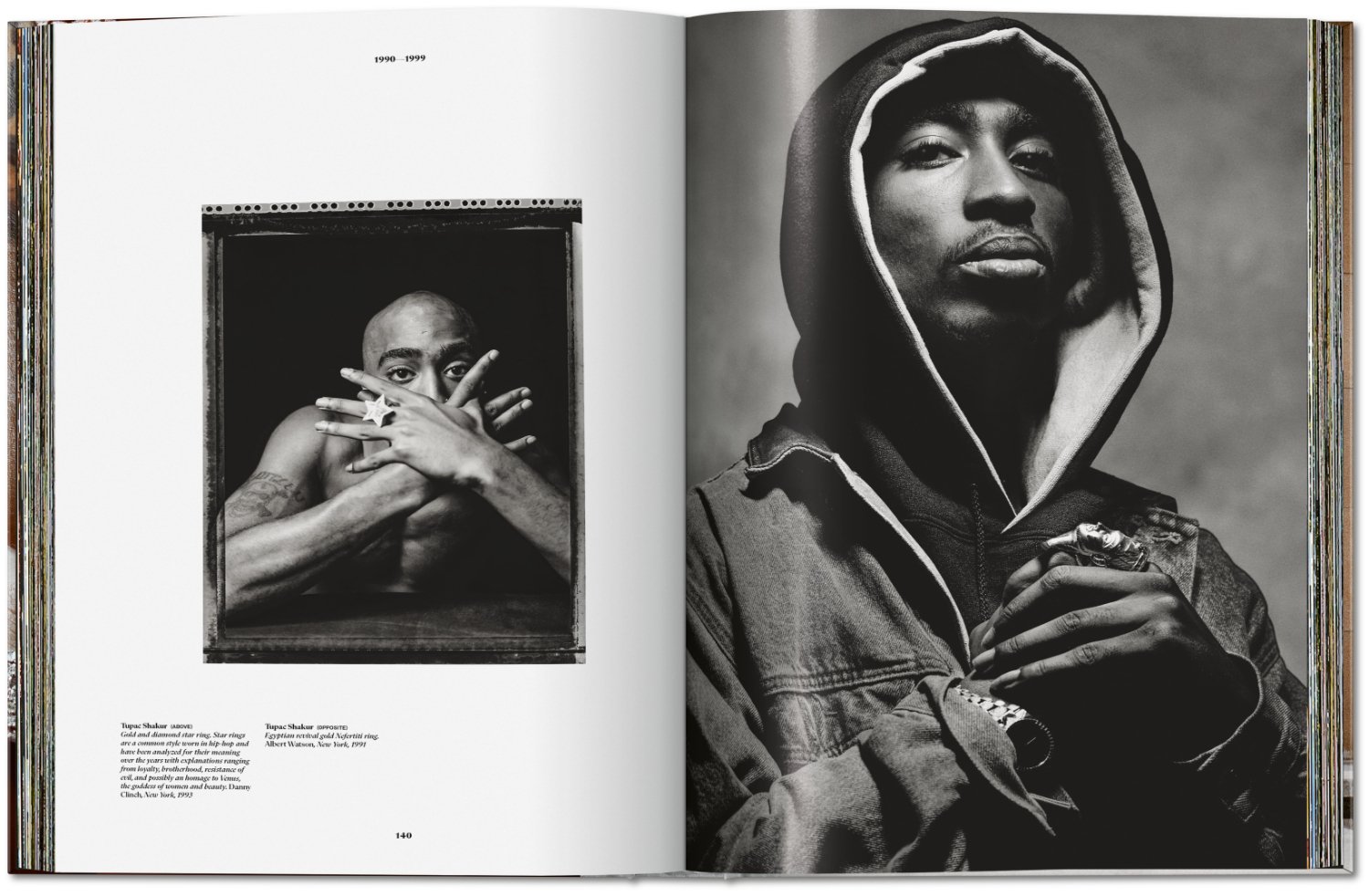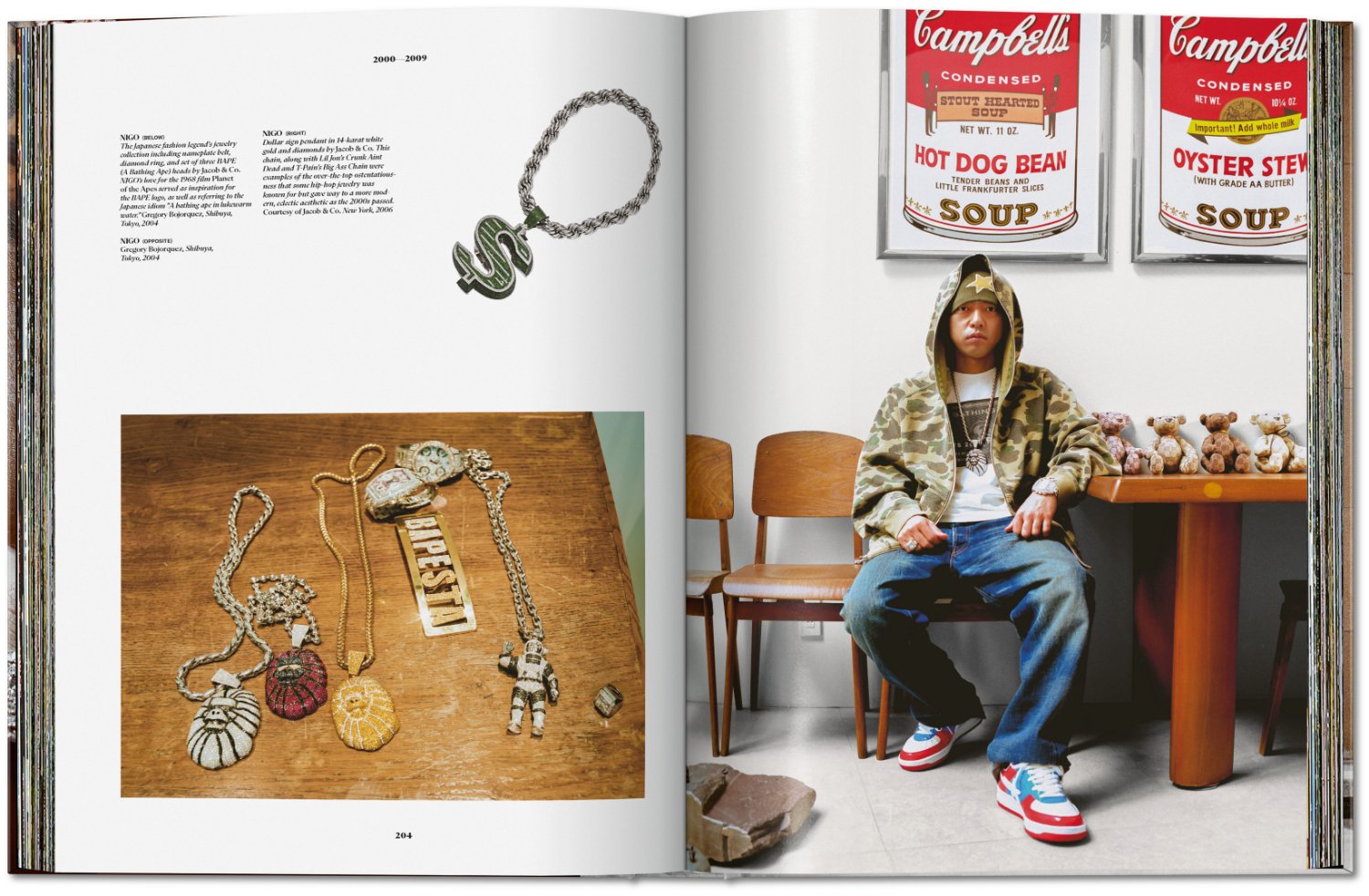And the Winner Is…
The 2023 Booktique Book of the Year has it all—dazzling photography, star-studded stories and interviews, irresistibly readable texts, cultural heft, and a blinged-out cover that is as much fun as it is a triumph of 21st century book design. Make room on your coffee table for Ice Cold: A Hip-Hop Jewelry History by Vikki Tobak.
ICE COLD
A Hip-Hop Jewelry History
By Vikki Tobak
PUBLISHER: TASCHEN
RETAIL PRICE: $100
DETAILS: HARDCOVER, 388 PAGES, 13.4” X 9.8”
Featuring essays by:
Hip-hop superstar Slick Rick
A$AP Ferg
LL CooL J
Kevin “Coach K” Lee
Pierre “P” Thomas of Quality Control Music
Spanning the history of hip-hop jewelry, from the 1980s to today, Ice Cold is a stunning compilation of storytelling and visuals. Hundreds of extraordinary images of every major hip-hop artist on record celebrate how “Ice” has become a proclamation of identity and self-expression. Starting with Run-DMC’s gold Adidas pendants and Eric B. & Rakim’s ostentatious dookie rope chains and Mercedes medallions, the jewelry then transforms from street style into a booming design culture. The hip-hop tradition of “show up and show out” reaches new heights with artists like Pharrell Williams, Jay-Z, Gucci Mane, and Cardi B, whose over-the-top pieces integrate unique pop culture references, unconventional materials, and enduring artist collaborations. Glittering jewels are the shining statement of a collective identity: unapologetic, charismatic, and street savvy. Ice Cold goes beyond the ostentatious bling to reveal a transformative story that is loud and proud.
Look inside the book
FROM THE BOOK’S INTRODUCTION
"On the storied block of New York City’s West 47th Street between Fifth and Sixth Avenues, you can feel the buzzy, frantic, larger-than-life street dreams of the jewelry trade, the Diamond District pulsating with big numbers, big Cuban links, and big aspiration. They’re such seemingly simple yet richly storied commodities: Pt, Ag, Au, and C — platinum, silver, gold, and of course, carbon, which when compressed under pressure forms a diamond.
Like diamonds, hip-hop emerged under pressure to create a rarefied thing of pure excellence."
Meet the Author
Just like her volume on the arc of hip-hop jewelry, the culture journalist and curator VIKKI TOBAK has an ear for bigger narratives.
Cuban links, pendants, knuckle rings, and grills are the accoutrements New York-based author Vikki Tobak uses to explore the rise of hip-hop, one of the most influential cultural forces in recent years. Through scholarship, extensively-curated photography, and texts she gathered from collaborators Ricky “Slick Rick” Walters, A$AP Ferg and LL Cool J, Tobak’s Ice Cold: A Hip-Hop Jewelry History delves into subcultures and the traditions fueling them, as well as the artisans who fashion precious metals into bold personal statements.
Tobak, a self-described “photo nerd” whose family immigrated to music powerhouse Detroit from Kazakhstan when she was five, arrived in New York in her teens. There, a job at Payday Records led to an early career in the industry followed by music journalism with stories for Vibe, The Fader, Paper magazine and now three books on hip-hop.
Below, we chatted with Tobak as she’s preparing to turn Ice Cold into an exhibition of photography and jewelry, slated for spring 2024.
Vikki Tobak (third from right) in conversation about Ice Cold: A Hip-Hop Jewelry History with (L-R) Jamila Stewart, Lillian Shalom, Maxwell Osborne, Corey Stokes, and David Tamargo at NYA Studios, Los Angeles, on October 19, 2023. © BFA 2023. Photo by Jenna Burke/BFA.com.
Hi Vikki! Tell us how Ice Cold came to be. I’ve been writing about hip-hop since the early 1990s. Along with music, I’ve always known that all the sartorial choices from sneakers to jewelry to the way the music expressed itself visually were such a big part of it. Jewelry was this great subculture within the culture. It said so much and it changed as the music changed, and I thought, it’s time to tell that story.
You arranged the book by decade. What inspired you to structure it this way? I kept coming back to chronological order, starting with the 1980s, and where artists lived. In the 1990s, hip-hop started to step into its power. Labels formed, and the jewelry reflected that. You can see it changing. Early on it’s primarily gold and smaller chains, earrings and nugget rings. Then you start to see the bigger chunky ropes, medallions, then later diamonds and platinum come into the scene. Now the sky is the limit with Pharrell Williams’ colored gemstones, and artists are thinking about sustainability, [considering] where the diamonds are found and who makes them.
You write that, on the street, “style speaks to the power of possibility.” Tell us a bit more about that. Especially in a culture like hip-hop, style was more than conspicuous consumption. It was a communication tool, your identity, a way to telegraph to the world who you were. It means so much to step out on the street, in the club, and show yourself. It signaled making it, notions of power, transcending your circumstances. I think that’s really powerful given what the music had to start with. And as the music evolved, so did all this wealth. Fast forward to someone like Jay-Z who doesn’t wear a lot of jewelry anymore. He wears great watches. It’s not as flashy; it’s more about generational wealth.
As a longtime music journalist, what was it like to go deep into another subject—jewelry—as you explored the convergence of jewelry and hip-hop scenes? Not only was jewelry a very male-dominated world, but hip-hop was too, so it was something I was used to. Much of these worlds are run by immigrants or children of immigrants—New York’s diamond district and also Canal Street. These are immigrant start-ups, hustler cultures. I was interested in the similarities between that and hip-hop. How did those worlds intersect?
Erykah Badu and Missy Elliott are pictured in the book with some incredible pieces. Missy and Erykah are two of my favorite collectors. What Erykah does with her grills is just incredible. And the moving parts on Missy’s turntable ring. They’re super inspiring. Women have come a long way on making decisions career-wise and where they’re spending money. But there’s judgement too. Cardi B. was showing off watches in a YouTube video and people asked if she even had a house yet, questioning a young woman of color. There are so many layers to this book.
What part of making this book was especially fun or memorable for you? I really enjoyed seeing how much this newer generation of artists—Tyler, the Creator, ASAP Rocky, Lil Yachty—is aware of jewelry history, and how they’re so inspired by people like Pharrell Williams. It was really interesting to delve into what they knew of pieces that came before them and their take on what’s happening now. You see this continuum manifest in this current generation. Hip-hop is about remixing; it gets reinvented again and again.
What’s on your coffee table right now? Mitchell S. Jackson’s Fly: A Big Book of Basketball Fashion, a style history of basketball culture. Also Pharrell’s new book, Pharrell: Carbon, Pressure & Time: A Book of Jewels. It’s only his jewelry and it’s great.
PRAISE FROM THE JUDGES
-

Carol Lim
FASHION ENTREPRENEUR
"From the spine to the front cover to the content inside, Ice Cold appealed to me on all levels.”
-

Joy Cho
CREATIVE DIRECTOR
"I just loved seeing and reading the history behind such a specific topic. Ice Cold proves there really is a book for everything!”
-

Hilton Carter
PLANT STYLIST
“Ice Cold got me thinking about my goals for my next book. Understanding the weight jewelry played in hip-hop as an art form, I’m inspired to capture the equivalent in the interiors space.”
-

Grier Stockman
TEXTILE DESIGNER
"The point Ice Cold makes so well is that, more than vibe, jewelry in hip-hop is a phenomenon that reflects the cultural and social dynamics within which the genre of hip-hop operates. Textiles function similarly. They're something to behold, sure, but they also encapsulate social histories.”
Buy the Book
ICE COLD
A Hip-Hop Jewelry History
BY VIKKI TOBAK
INTRODUCTION BY SLICK RICK
PUBLISHER: TASCHEN
RETAIL PRICE: $100
DETAILS: HARDCOVER, 388 PAGES, 13.4” x 9.8”
More awards coverage
Meet the Judges
Celebrate coffee table books with Jonathan Adler, designer Brigette Romanek, chef Chris Morocco, gardening star Hilton Carter, and more of your favorite figures.
Shop the Honorees
Find your next coffee table centerpiece—or the perfect gift—in our alphabetized gallery of 2023 Booktique Awards winners and finalists.
Explore the Winners by Category
Discover the top-ranked books in Art & Design, Fashion, Lifestyle, Our World, Performing Arts, and Travel Inspiration.
More to Explore
























